Bird's Nest Fern
(Asplenium nidus)
(Spleenwort family)
low to medium light
water every 3-4 days (moist not soggy)
(don't water the crown or plant will develop diseases)
needs humidity: use pebble tray
(misting makes it susceptible to bacterial/fungal infections such as Erwinia Blight)
Feed once/twice in Spring/Summer when plant is actively growing (use balanced fertilizer, diluted to 1/2 strength)
Pests: Mealy Bugs/Scale/Aphids
- don't spray liquid on the crown (use alcohol swab to clean near crown)
Propagation: very difficult. Propagated by spores, not plant division like many ferns
Native to rainforests of Africa/Asia/Australia
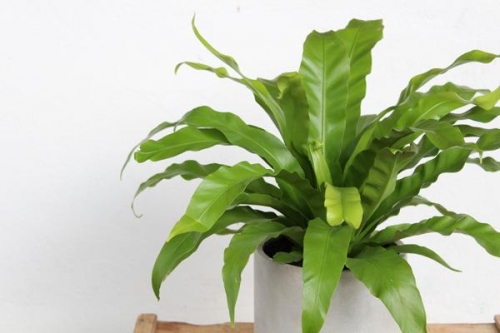
Boston Fern
(Nephrolepis exaltata)
low-medium light
water: once every 7-10 days (when top 1-2" dry, finger test) (more drought-resistant than most ferns)
Soil: indoor potting soil, with extra peat moss for faster drainage
Humidity: Ferns prefer humidity (leaves may turn brown otherwise)
clean air: plants remove formaldehyde from the air
growth habit: wide (fronds up to 2')
Fertilizer: once a month in Spring/Summer. 1/2 strength balanced liquid fertilizer)
Pests: Aphids/Mealy Bugs/Spider Mites
Solution: Spray with soapy water, spraying pesticides causes fronds to turn brown
Repotting: Ferns do best when root-bound, but if repotted then don't fertilize for several weeks
Pruning: cut dead fronds off plant as they drain energy from the plant
Propagation: by division
Native to tropical forests/swamp regions across the world
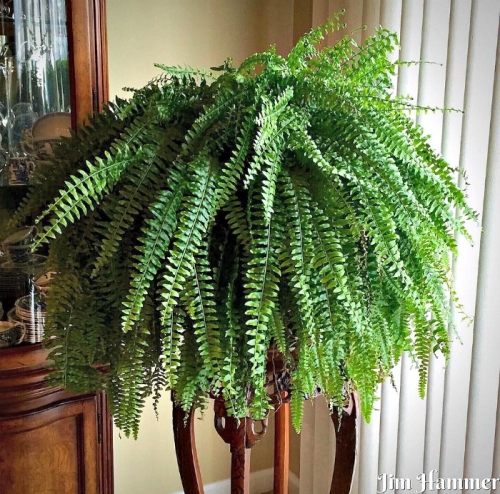
Kentia Palm
(Howea forsteriana)
low-medium light
water: once every 7-10 days (when top 1-2" is dry)
(overwatering, resulting in root rot, is the main reason why Kentia Palms die)
(Kentia's, like most palms, are sensitive to salt/chlorine/fluoride so best to leave water out overnight before watering)
Soil: well-drained potting soil
Fertilizer: slow-growing, fertilize once a month in Spring/Summer with balanced liquid fertilizer diluted to 1/2 strength
Pests: Spider Mites/Mealy Bugs
(spray soap solution/insecticidal soap/neem oil)
Propagation: by seeds, so very difficult
Native to Australia/New Zealand
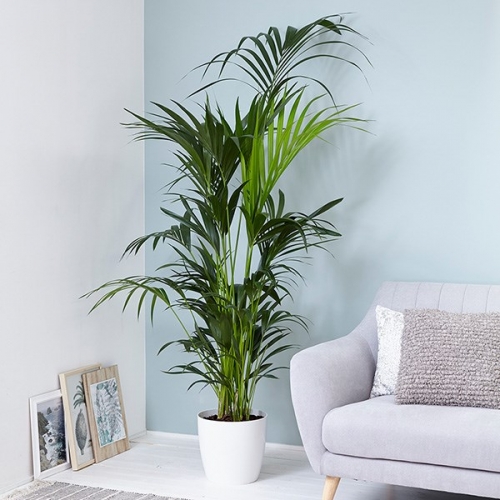
Table/Brake Fern
(Pteris cretica wimsetti)
low-medium light
water: once every 7-10 days (top 1-2" dry, finger test)
Soil: indoor potting soil, extra peat helps drainage
Prefers Humidity
Fertilizer: Once a month in Spring/Summer, liquid fertilizer diluted to 1/2 strength
Growth habit: 2'x2'
Propagation: by division (need at least 2 fronds + section of the rhizome)
Native to Europe/Asia/Africa
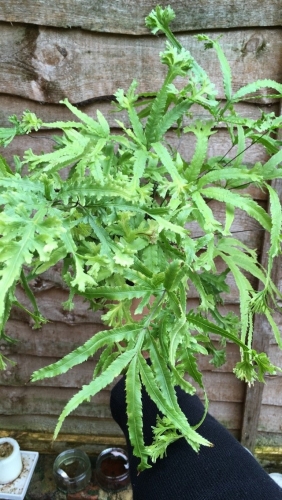
Peace Lily
(Spathiphyllum)
low-medium light
water: once every 14 days (top 1-2" should be dry, finger-test) (overwatering causes leaves to turn blackish brown)
Clean air: great plant for removing benzene, formaldehyde, carbon monoxide)
Remove dust from leaves, keep them shiny for aesthetics and prevents any obstruction of photosynthesis
Soil: potting soil with extra peat for drainage
Flowers: "Spathes" last for several weeks
(Remove flowers at base to encourage more flowering). More flowers produced as plant matures
Fertilize: once a month in Spring/Summer with 1/2 strength liquid fertilizer
Pests: Aphids/Spider Mites/Mealy Bugs
Propagation: by division
Native to tropical forests across the world. Grows low to the ground on forest floor (thus it can develop flowers in low to medium light)
Poisonous to pets/small children

Green Dracaena
(Dracaena deremensis 'Janet Craig')
low-medium light
water: once every 14 days (top 1-2" inches should be dry)
Fertilizer: not necessary, but could feed twice a year in Spring/Summer with 1/2 strength balanced liquid fertilizer)
Soil: fast-draining potting soil
Great for cleaning the air
Pests: Mealy Bugs/Scale
Diseases: Leaf Spot
Repotting: prefer to be more root bound
Native to tropical Africa
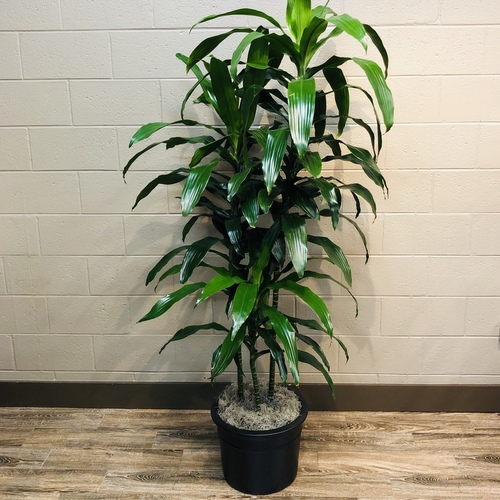
False Aralia
(Dizygotheca elegantissima / Finger Aralia)
high light
water: once every 7-10 days (drooping foliage is a sign of overwatering while falling leaves indicate soil is dry at roots)
Soil: regular potting soil
Pests: Aphids/ Mealy Bugs
Fertilizer: once a month during Spring/Summer, 1/2 strength balanced liquid fertilizer
Propagation: seeds/stems....difficult
Native to Australia/S.E. Asia
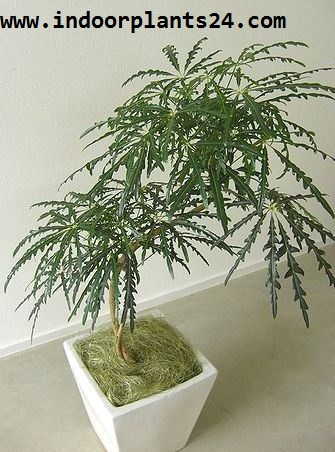
Pothos / Devil's Ivy
(Epipremnum aureum)
low-medium light
('Green Jade' with solid green leaves do best in low light.
'Golden Pothos' with yellow/green leaves likes medium light.
'Marble Queen' with green/white leaves likes medium-bright light)
Water: approx once every 14 days
(overwatering is main reason plant dies. Once pathos roots are destroyed, through root rot etc, it is difficult to save the plant)
Clean air plant
Great plant for beginners
Soil: good drainage soil
Fertilizer: biweekly in Spring/Summer with balanced liquid fertilizer at 1/2 strength
Pests: Mealy Bugs. Fungus Gnats if soil stays too wet
Propagation: stem cuttings (5" stem, remove leaves from bottom couple of inches, dip in rooting hormone, and place in moist soil, cover with bag to provide humidity, and check every few days that soil remains moist. After a few weeks, test by gently pulling on stem, if resistance then roots have begun to form and plant has been propagated successfully).
Native to jungles of Malaysia
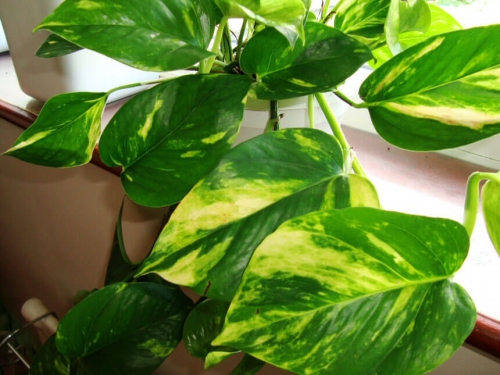
Kimberly Queen Fern
(Nephrolepis obliterata / Australian Sword Fern)
low-medium light
water: every 7-10 days
(underwatering: pale green fronds / overwater: crispy brown fronds in center of fern)
Clean air plant: removes formaldehyde
Repotting: not often, ferns prefer to be slightly root bound
Pests: Aphids/Mealy Bugs/Spider Mites
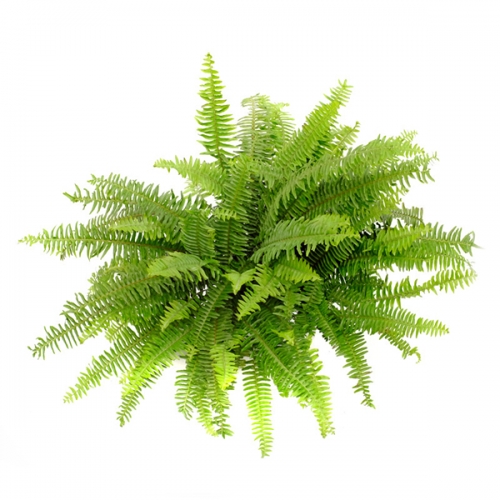
Cordyline fruticosa 'glauca'
(Cordyline terminalis)
medium light
water: once a week, keep moist/not soggy
Good clean air plant
prefers humidity if possible
wipe leaves with damp cloth to remove dust (assists photosynthesis and maintains aesthetics)
Growth habit: moderate growth to 5'
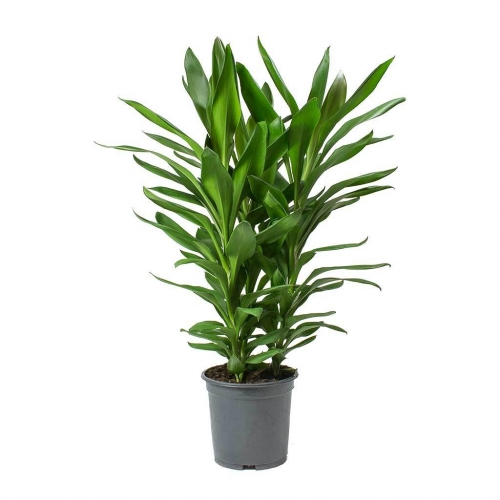
Chinese Evergreen
(Aglaonema crispum / Pewter Plant)
low-medium light
water: once a week (keep moist/not soggy)
Prefers humidity
Great clean air plant
Soil: fast draining/well-aerated
Flowers: not attractive. Remove when they appear as they drain energy
Propagation: stem cuttings / division
Native to S.E. Asia
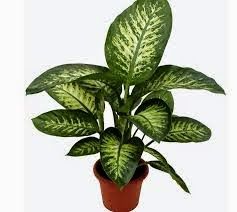
Cast-Iron Plant
(Aspidistra elatior)
low light
water: once every 2 weeks
Soil: rich organic soil, such as African violet mix
Fertilizer: Perhaps once a month during Spring/Summer, 1/2 strength balanced liquid fertilizer
Pests: Mealy Bugs/Spider Mites
Diseases: Leaf spot (needs good air circulation)
Propagation: by division
Native to China
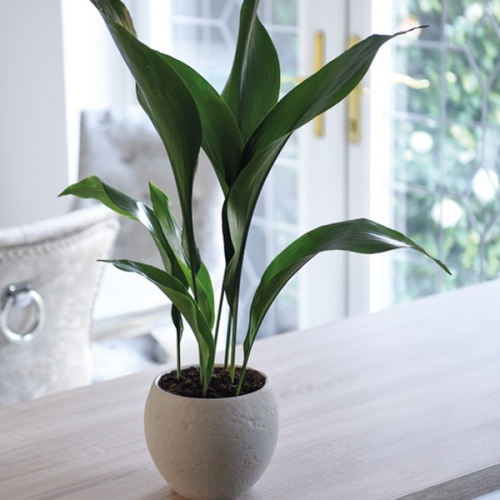
Snake Plant / Mother-in-law's Tongue
(Sansevieria trifasciata)
low light (can handle any light well, grows faster in brighter light)
water: once every 2-3 weeks (overwatering is main cause of plant death)
Great clean air plant
Soil: well-draining, possibly a cactus mix/potting soil mix
Growth: can get up to 4'
Fertilizer: use cactus plant food, once a month in Spring/Summer, diluted to 1/2 strength
Repotting: prefers to be root bound
Pests: Pretty much immune to pests
Propagation: by division / leaf cuttings
Native to South Africa

Maidenhair Fern
(Adiantum cuneatum)
More care required
low-medium light
water: twice a week
Soil: fast draining
Prefers humidity. Needs constant temperature (don't let temperatures fluctuate too much)
Fertilizer: Biweekly in Spring/Summer, 1/2 strength balanced liquid fertilizer
Pests: Aphids/Mealy Bugs/Scale
Solution: Wash whole plant in soapy water
Disease: Gray Mold (due to high humidity requirements)
Remove dying fronds quickly so plant can adequately maintain energy
Propagation: by division
Native to Brazil
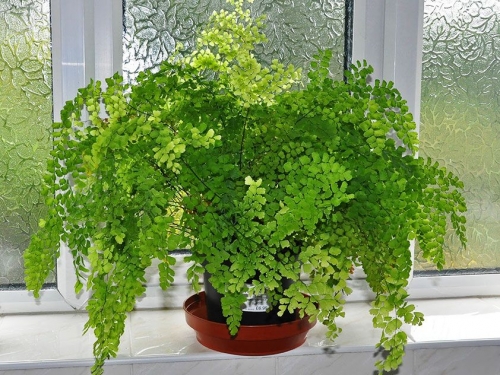
Heartleaf Philodendron
(Philodendron cordatum)





